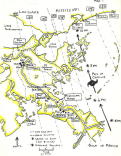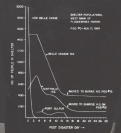
| SHELTER |
Maximum
Population (approximate) |
Opening Date |
Closing Date |
Days Open |
| US Naval Air Station, Belle
Chasse |
2000 |
16 August |
20 August |
4 |
| Belle Chasse High School |
1700 |
16 August |
1 September |
15 |
| Scottville High School |
800 |
16 August |
1 September |
15 |
| Port Sulphur High School |
105 |
20 August |
31 August |
11 |
| Buras High School |
400 |
1 September |
11 November |
71 |
| Sunrise High School |
126 |
1 September |
November 30 + |
90+ |
 exited during the next 2
weeks, as their homes were repaired. On September 1st, the 15th
post-disaster day, the 400 remaining residents were transported to
Buras High School. By now they represented a fairly stable population,
of persons whose homes were destroyed or sustained major damage.
exited during the next 2
weeks, as their homes were repaired. On September 1st, the 15th
post-disaster day, the 400 remaining residents were transported to
Buras High School. By now they represented a fairly stable population,
of persons whose homes were destroyed or sustained major damage.| SHELTER OCCUPANCY,
Person-days; PDD = Post-disaster Day |
|||||
| SHELTER POPULATIONS (Predominant Race) |
1st Week PDD 0-7 |
2nd Week PDD 8-14 |
3rd Week PDD 15-21 |
4th Week PDD 22-28 |
1st Month PDD 0-28 |
| Belle Chasse-Buras High Schools (White) | 10750 |
4250 |
2735 |
2651 |
20386 |
| Scottville-Sunrise High Schools
(Black) |
4624 |
2220 |
889 |
815 |
8548 |
| Port Sulphur High School (White) |
440 |
556 |
0 |
0 |
996 |
| Belle Chasse Naval Air Station
(Black)* |
na |
na |
na |
na |
na |
| TOTAL |
15814 |
7026 |
3624 |
3466 |
29930 |
| Post-Disaster
Day (PDD) #0 = August 17, 1969 -- Note that first week includes 8
days; *na = occupancy not available |
|||||
| REASONS
FOR VISITS TO MEDICAL AID STATIONS, FIRST MONTH (PDD 0-28) |
||||
| CONDITION |
Belle Chasse-Buras
(White) |
Scottville-Sunrise
(Black) |
||
| New Visits |
Revisits |
New Visits |
Revisits |
|
| Acute Open Injuries |
378 |
38 |
100 |
6 |
| Acute Closed Injuries |
56 |
4 |
12 |
2 |
| Skin & Wound Infections |
170 |
71 |
131 |
61 |
| ENT & Resp Infections |
251 |
23 |
198 |
119 |
| Diarrhea |
82 |
15 |
14 |
19 |
| Non-Diarrhea Digestive |
90 |
5 |
42 |
1 |
| Headache, Nerves, etc. |
131 |
17 |
91 |
6 |
| Chronic Non-Diabetic |
53 |
32 |
51 |
22 |
| Diabetic Conditions |
20 |
70 |
21 |
6 |
| Allergic and Non-Inf Skin |
68 |
2 |
31 |
1 |
| Obstetric Conditions |
10 |
3 |
2 |
7 |
| Tetanus Shot Only |
43 |
0 |
3 |
0 |
| Birth Control Rx Only |
14 |
0 |
3 |
0 |
| Other Miscellaneous |
173 |
28 |
72 |
7 |
| No Diagnosis or Rx Recorded |
174 |
46 |
28 |
8 |